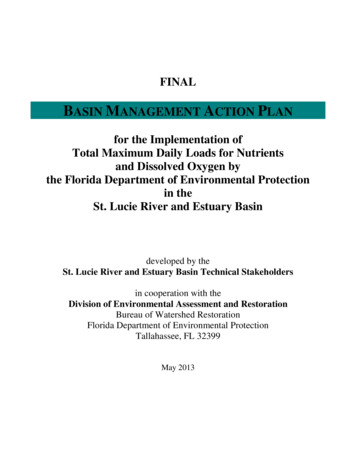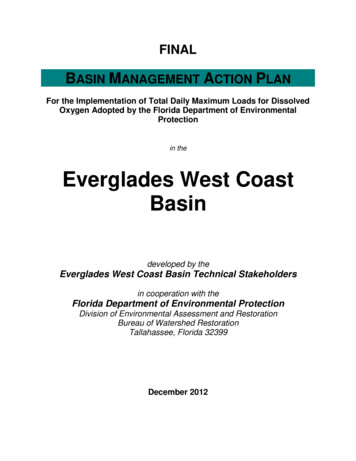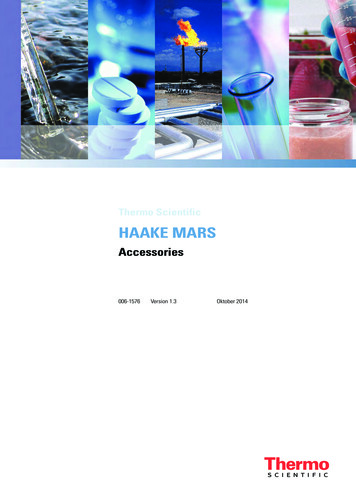
Transcription
FINALBASIN MANAGEMENT ACTION PLANfor the Implementation ofTotal Maximum Daily Loads for Nutrientsand Dissolved Oxygen bythe Florida Department of Environmental Protectionin theSt. Lucie River and Estuary Basindeveloped by theSt. Lucie River and Estuary Basin Technical Stakeholdersin cooperation with theDivision of Environmental Assessment and RestorationBureau of Watershed RestorationFlorida Department of Environmental ProtectionTallahassee, FL 32399May 2013
Final St. Lucie River and Estuary Basin Management Action Plan – May 2013ACKNOWLEDGMENTSThe St. Lucie River and Estuary Basin Management Action Plan was prepared as part of a statewidewatershed management approach to restore and protect Florida’s water quality. It was developed by theSt. Lucie River and Estuary Basin stakeholders, identified below, with participation from affected local,regional, and state governmental interests; elected officials and citizens; and private interests.ST. LUCIE RIVER AND ESTUARY BASIN PARTICIPANTS- Empty cell/no dataALLOCATION ENTITIESAGENCIESFlorida Department of Agricultureand Consumer ServicesFlorida Department ofEnvironmental ProtectionSouth Florida Water ManagementDistrict-Harbor Branch OceanographicInstituteSt. Lucie West Services District-City of StuartCopper Creek CommunityDevelopment DistrictFlorida Department ofTransportation – District 4Florida Turnpike--------Hobe St. Lucie Conservancy DistrictNorth St. Lucie River Water ControlDistrictPal Mar Water Control District------Town of Sewall’s PointTradition Community DevelopmentDistrictTroup-Indiantown Water ControlDistrictVerano Community DevelopmentDistrict--------Agricultural ProducersMartin CountyOkeechobee CountySt. Lucie CountyCity of Fort PierceCity of Port St. LuciePage ii of xviOTHER INTERESTED PARTIESFlorida Fruit and VegetableAssociationFlorida Oceanographic Society
Final St. Lucie River and Estuary Basin Management Action Plan – May 2013For additional information on Total Maximum Daily Loads and the watershed management approach inthe St. Lucie River and Estuary Basin, contact:Katie Hallas, Basin CoordinatorFlorida Department of Environmental ProtectionBureau of Watershed Restoration, Watershed Planning and Coordination Section2600 Blair Stone Road, Mail Station 3565Tallahassee, FL 32399-2400Email: Katie.Hallas@dep.state.fl.usPhone: (850) 245–8432Page iii of xvi
Final St. Lucie River and Estuary Basin Management Action Plan – May 2013TABLE OF CONTENTSLIST OF ACRONYMS AND ABBREVIATIONS . IXEXECUTIVE SUMMARY . XICHAPTER 1 : CONTEXT, PURPOSE, AND SCOPE OF THE PLAN .11.1Water Quality Standards and TMDLs .11.2TMDL Implementation .31.3St. Lucie River and Estuary BMAP .31.3.1Stakeholder Involvement .41.3.2Other Support and Interested Parties .61.3.3Plan Purpose and Scope .61.3.4BMAP Approach .101.3.5Pollutant Reduction and Discharge Allocations.111.3.6St. Lucie River and Estuary Basin TMDLs .121.4Assumptions and Considerations Regarding TMDL Implementation .131.4.1Assumptions .131.4.2Considerations .141.5Future Growth in the Watershed .18CHAPTER 2 : ST. LUCIE RIVER AND ESTUARY BASIN SETTING .202.1Land Use Coverage .202.2Hydrology and Topography .202.3Water Quality Trends.22CHAPTER 3 : POLLUTANT SOURCES AND ANTICIPATED OUTCOMES .243.1Summary of Sources in the TMDL .243.1.1MS4s .243.1.2Nonpoint Sources .273.1.3Agriculture .283.1.4Aquaculture .283.2Anticipated Outcomes of BMAP Implementation .28CHAPTER 4 : DETAILED ALLOCATIONS .304.1Collaborating with St. Lucie River Watershed Protection Plan Efforts .304.2Calculating Starting Loads .314.3Natural Land Uses and FPL Cooling Pond .354.4De Minimus Determination .354.5Target Load per Acre .374.6Allocations and Required Reductions .384.7Allocations by Source .394.7.1MS4s .394.7.2Nonpoint Sources .404.7.3Agriculture .40CHAPTER 5 : MANAGEMENT ACTIONS .41Page iv of xvi
Final St. Lucie River and Estuary Basin Management Action Plan – May 20135.15.25.3MS4 Projects To Meet Allocations .41Nonpoint Source Projects .43Provisional BMPs .445.3.1Floating Islands .455.3.2Public Education and Outreach.455.3.3Muck Removal .465.3.4Aquatic Plant Harvesting .465.3.5Water Control Structures .475.3.6Septic Tank Phase Out .475.4Regional Projects .475.5Agriculture.475.5.1Agricultural Producers’ Responsibilities Under the FWRA .495.5.2Agricultural BMPs .505.5.3FDACS OAWP Role in BMP Implementation and Follow-Up .535.5.4Department and SFWMD Roles in BMP Implementation .545.5.5BMP Enrollment Goals and Load Reduction Estimates .545.5.6WCD Agricultural Allocations.595.5.7Beyond BMPs .605.6SFWMD Pollutant Source Control Program .61CHAPTER 6 : ASSESSING PROGRESS AND MAKING CHANGES .636.1Tracking Implementation .636.2Adaptive Management Measures .646.3Water Quality Monitoring .656.3.1Monitoring Objectives .656.3.2Monitoring Parameters, Frequency, and Network .656.3.3Biological Monitoring.736.3.4Data Management and Assessment .736.3.5QA/QC.746.4Research Priorities .74CHAPTER 7 : COMMITMENT TO PLAN IMPLEMENTATION .76APPENDICES .77Appendix A: TMDL Basin Rotation Schedule.78Appendix B: Summary of Statutory Provisions Guiding BMAP Development andImplementation .79Appendix C: Summary of Environmental Protection Agency-Recommended Elementsof a Comprehensive Watershed Plan .85Appendix D: BMP Efficiencies and Projects To Achieve the TMDL .90Appendix E: Glossary of Terms .107Appendix F: Bibliography of Key References and Websites .113Page v of xvi
Final St. Lucie River and Estuary Basin Management Action Plan – May 2013LIST OF FIGURESFigure ES-1: St. Lucie River and Estuary Basin . xiiiFigure 1: St. Lucie River and Estuary Basin .8Figure 2: St. Lucie River and Estuary BMAP Basin Compared with SLRWPP Basin .9Figure 3: St. Lucie River and Estuary BMAP Study Area .16Figure 4: 2004 Land Uses in the St. Lucie River And Estuary Basin .21Figure 5: 2004 Agricultural Lands in the St. Lucie River and Estuary Basin.49Figure 6: BMP Enrollment in the St. Lucie River and Estuary Basin as of December 31, 2012 .57Figure 7: Water Quality Monitoring Network for the Southern Part of the St. Lucie River andEstuary .70Figure 8: Water Quality Monitoring Network for the Northern Part of the St. Lucie River andEstuary .71Figure 9: Flow Monitoring Network for the St. Lucie River and Estuary .72Figure 10: Biological Monitoring Network for the St. Lucie River and Estuary .75Page vi of xvi
Final St. Lucie River and Estuary Basin Management Action Plan – May 2013LIST OF TABLESTable ES-1: TMDLs in the St. Lucie River and Estuary Basin . xivTable 1: Designated Use Attainment Categories for Florida Surface Waters .2Table 2: Phases of the Watershed Management Cycle .3Table 3: St. Lucie River and Estuary TMDLs .12Table 4: 2004 Land Uses in the St. Lucie River and Estuary Basin .20Table 5: Local Governments in the St. Lucie River and Estuary Basin Designated as MS4s .25Table 6: TN Starting Loads by Entity .32Table 7: TP Starting Loads by Entity .33Table 8: Acres by Entity .34Table 9: TN De Minimus Determination .36Table 10: TP De Minimus Determination .36Table 11: TN Target Loads per Acre .37Table 12: TP Target Loads per Acre .37Table 13: TN Allocations and Total Required Reductions .38Table 14: TP Allocations and Total Required Reductions .39Table 15: TN and TP Reductions for the MS4s .40Table 16: TN and TP Reductions for Nonpoint Sources .40Table 17: TN and TP Reductions for Agriculture.40Table 18: Summary of MS4 Load Reductions for TN by Project Type.43Table 19: Summary of MS4 Load Reductions for TP by Project Type .43Table 20: Summary of Nonpoint Source Load Reductions for TN by Project Type .44Table 21: Summary of Nonpoint Source Load Reductions for TP by Project Type .44Table 22: Agricultural Land Uses in the St. Lucie River and Estuary Basin Outside WCDBoundaries, 2004 SFWMD Land Use Data .48Table 23: Agricultural Acreage, BMP Enrollment, and Future Enrollment Goals for the St. LucieRiver and Estuary BMAP Area .56Table 24: Agricultural TN and TP Load Reduction Allocations and Estimated Reductions in TNand TP Loads in the First Five Years .59Table 25: All Agricultural Lands TN and TP Load Reduction Allocations and Estimated Creditsin the First Five Years .59Table 26: BMAP Monitoring Network.67Table 27: Biological Monitoring .73Table A-1: Major Hydrologic Basins by Group and Department District Office .78Table D-1: Efficiencies for Standard Stormwater BMPs .91Table D-2: Efficiencies for Provisional Stormwater BMPs .92Table D-3: City of Fort Pierce Projects .93Table D-4: City of Port St. Lucie MS4 Projects .94Table D-5: City of Stuart Projects .96Table D-6: FDOT District 4 Projects .97Page vii of xvi
Final St. Lucie River and Estuary Basin Management Action Plan – May 2013Table D-7: Hobe St. Lucie Conservancy District Projects .98Table D-8: Martin County Projects .99Table D-9: North St. Lucie River WCD Projects .101Table D-10: Pal Mar WCD Projects .102Table D-11: St. Lucie County MS4 Projects .103Table D-12: St. Lucie County Non-MS4 Projects .104Table D-13: Town of Sewall’s Point Projects .105Table D-14: Troup-Indiantown WCD Projects .106Table D-15: Turnpike Authority Projects .106Table F-1: Local and Regional Stormwater and Water Quality Protection Websites .114Table F-2: State Stormwater and Water Quality Protection Websites .114Table F-3: National Stormwater and Water Quality Protection Websites .114Page viii of xvi
Final St. Lucie River and Estuary Basin Management Action Plan – May 2013LIST OF ACRONYMS AND ELAPNOINPDESNRCSO&MOAWPPOTWPSAQA/QCROCSFWMDBasin Management Action PlanBest Management PracticeBiochemical Oxygen DemandCommunity Development DistrictContinuous Deflective Separation (Unit)Florida Department of Environmental ProtectionDissolved OxygenEvent Mean ConcentrationU.S. Environmental Protection AgencyEnvironmental Resource PermitEastern Watershed Improvement ProjectFlorida Administrative CodeFlorida Department of Agriculture and Consumer ServicesFlorida Department of TransportationFlorida Power & LightFlorida StatutesFlorida Stormwater AssociationFlorida State UniversityFlorida Watershed Restoration ActFlorida Yards and NeighborhoodsGeographic Information SystemHybrid Wetland Treatment TechnologyIndian River LagoonIndian River Lagoon SouthImpaired Surface Waters RulePounds Per YearLow Impact DevelopmentLake Okeechobee Protection ActManaged Aquatic Plant SystemMaximum Extent PracticableMilligrams Per LiterMunicipal Separate Storm Sewer SystemMetric Tons Per YearNorthern Everglades and Estuaries Protection ProgramNational Environmental Laboratory Accreditation ConferenceNational Environmental Laboratory Accreditation ProgramNotice of IntentNational Pollutant Discharge Elimination SystemNatural Resources Conservation ServiceOperations and MaintenanceOffice of Agricultural Water PolicyPublicly Owned Treatment WorksPublic Service AnnouncementQuality Assurance/Quality ControlRunoff CoefficientSouth Florida Water Management DistrictPage ix of xvi
Final St. Lucie River and Estuary Basin Management Action Plan – May FASUSGSWBIDWCDSt. Lucie River Watershed Protection PlanStandard Operating ProcedureStormwater Treatment AreaSTOrage and RETrieval (Database)Surface Water Improvement and ManagementTotal Kjeldahl NitrogenTotal Maximum Daily LoadTotal NitrogenTotal PhosphorusTotal Suspended SolidsTreatment TrainUniversity of FloridaUniversity of Florida–Institute of Food and Agricultural SciencesU.S. Geological SurveyWaterbody Identification (Number)Water Control DistrictPage x of xvi
Final St. Lucie River and Estuary Basin Management Action Plan – May 2013EXECUTIVE SUMMARYST. LUCIE RIVER AND ESTUARY BASINThe St. Lucie River and Estuary Basin is located in southeast Florida in Martin, St. Lucie, andOkeechobee Counties (see Figure ES-1). The St. Lucie Estuary is a major tributary to the SouthernIndian River Lagoon (IRL-S). The basin is an economically important area where water quality isaffected by freshwater runoff from agricultural and urban sources in the watershed and LakeOkeechobee (South Florida Water Management District [SFWMD] 2012a).The inland portion of the St. Lucie Estuary is composed of the South Fork and the North Fork. The twoforks converge at the Roosevelt Bridge to form a single waterbody that extends eastward, where it joinsthe IRL-S. Historically, this area included a much smaller natural watershed that directly contributed tothe river system. However, with the construction of drainage improvements in inland areas, theeffective drainage area of the St. Lucie Estuary and IRL-S expanded to include almost all of Martin andSt. Lucie Counties. The C-44 canal and its associated locks and water control structures wereconstructed to provide a navigable connection between the east and west coasts of Florida. The C-44canal also serves as a flood control conveyance for Lake Okeechobee and transports water from the lakeinto the South Fork. In addition, the C-44 canal transports runoff from the C-44/S-153 sub-basin. Theconstruction of Canals C-23 and C-24 (in addition to C-44) provided connections between theirrespective sub-basins. The C-23 and C-24 canals discharge to the North Fork (Florida Department ofEnvironmental Protection 2008).The overall St. Lucie River and Estuary Basin was divided into six sub-basins for this BasinManagement Action Plan. These sub-basins, which also comprise some of the sub-watersheds in theSFWMD St. Lucie River Watershed Protection Plan (SLRWPP) and the associated 2012 SLRWPPUpdate, are as follows: Basins 4, 5, and 6. C-23. C-24. C-44 and S-153.Page xi of xvi
Final St. Lucie River and Estuary Basin Management Action Plan – May 2013 North Fork. South Fork.TOTAL MAXIMUM DAILY LOADSTMDLs are water quality targets that are based on state water quality standards for specific pollutants,such as excessive nitrogen and phosphorus. The Department identified nine segments with waterbodyidentification (WBID) numbers in the St. Lucie River and Estuary Basin as impaired by nutrients. Thisdetermination was made based on concentrations of chlorophyll-a, dissolved oxygen (DO), and/orbiochemical oxygen demand (BOD) in each of the WBIDs. In March 2009, the Department adopted theSt. Lucie Basin TMDL for total phosphorus (TP), total nitrogen (TN), and BOD. Table ES-1 lists theTMDLs and pollutant load allocations adopted by rule for the WBIDs in the St. Lucie River and EstuaryBasin. TMDL loads in upstream WBIDs were calculated based on achieving the same targetconcentrations (0.72 milligrams per liter [mg/L] for TN and 0.081 mg/L for TP) as in the St. LucieEstuary. The TMDLs were used as the basis for the BMAP targets and allocation calculations.ST. LUCIE RIVER AND ESTUARY BASIN MANAGEMENT ACTION PLANParagraph 403.067(7)(a)1, Florida Statutes (F.S.), authorizes the Department to adopt BMAPs thatprovide for phased implementation of the strategies necessary to ultimately achieve the associatedTMDLs. This approach allows stakeholders to incrementally plan, budget, and execute projects whilesimultaneously monitoring and conducting studies to better understand the water quality dynamics(sources and response variables) in the watershed. For the St. Lucie River and Estuary Basin, the totalrequired reductions are spread over a 15-year timeframe. Reductions will be implemented in three fiveyear BMAP iterations, which align with the Department’s approach to evaluate basin health every fiveyears. This BMAP is the first five-year iteration for the St. Lucie River and Estuary Basin.During BMAP development, various stakeholders in the basin raised concerns about the BMAP modeland required reductions. The Department plans to refine the BMAP model during this first five-yeariteration. Therefore, the Department requested that the stakeholders provide information on activitiesand projects that would reduce a portion of the nutrient loading identified in the model. In this firstBMAP phase, the activities identified are not expected to achieve the TMDLs. Rather, this BMAP callsPage xii of xvi
Final St. Lucie River and Estuary Basin Management Action Plan – May 2013FIGURE ES-1: ST. LUCIE RIVER AND ESTUARY BASINPage xiii of xvi
Final St. Lucie River and Estuary Basin Management Action Plan – May 2013TABLE ES-1: TMDLS IN THE ST. LUCIE RIVER AND ESTUARY BASIN1Concentration in mg/L2National Pollutant Discharge Elimination SystemNPDES2WBID3193WATERBODYSt. Lucie EstuaryPARAMETERTNANNUAL TMDL TARGET(POUNDS OR[CONCENTRATION1])[0.720]STORMWATER(% REDUCTION)21.4%LOADALLOCATION(% REDUCTION)21.4%3193St. Lucie EstuaryTP[0.081]41.3%41.3%3194North ForkTN140,13425.0%25.0%3194North ForkTP15,76542.2%42.2%3194North ForkBOD[2.0]74.0%74.0%3194BNorth ForkTN103,74728.8%28.8%3194BNorth ForkTP11,67258.1%58.1%3197C-24 CanalTN348,95751.8%51.8%3197C-24 CanalTP39,25872.2%72.2%3197C-24 CanalBOD[2.0]33.3%33.3%3200C-23 CanalTN242,20251.7%51.7%3200C-23 CanalTP27,24878.6%78.6%3210South ForkTN24,46338.4%38.4%3210South ForkTP2,75257.2%57.2%3210ASouth ForkTN90,47147.1%47.1%3210ASouth ForkTP10,17861.8%61.8%3211Bessey CreekTN29,98123.9%23.9%3211Bessey CreekTP3,37351.2%51.2%3218C-44 CanalTN242,92951.2%51.2%3218C-44 CanalTP27,33055.0%55.0%3218C-44 CanalBOD[2.0]69.7%69.7%for projects and activities necessary to achieve reductions of 316,024.2 pounds per year (lbs/yr) (143.4metric tons per year [MT/yr]) of TN and 121,249.8 lbs/yr (55.0 MT/yr) of TP, which is 30% of theTMDL required reductions, by the end of the first 5-year iteration. After the first phase of BMAPimplementation, the Department and the stakeholders will evaluate progress and make adjustments usingadaptive management, as needed, to meet the remainder of the reductions to achieve the TMDLs.An important consideration for the restoration of the St. Lucie River and Estuary is that approximately42% of the freshwater inflows from canals that discharge into the St. Lucie Estuary are from LakeOkeechobee, based on data from 1996 through 2012. These releases carry significant nutrient loads,which have a known impact on the St. Lucie River and Estuary Basin. Lake Okeechobee has its ownTMDL for TP, and the Department is developing a separate BMAP to address those required reductions.Page xiv of xvi
Final St. Lucie River and Estuary Basin Management Action Plan – May 2013The implementation of activities to meet the Lake Okeechobee BMAP will likely have a positive effecton TN, as well.In 2007, the Lake Okeechobee Protection Act (LOPA) was expanded to include the St. Lucie andCaloosahatchee River watersheds. The legislation was renamed the Northern Everglades and EstuariesProtection Program (NEEPP) and required the SLRWPP to include a pollutant load reductionimplementation plan consistent with the St. Lucie River and Estuary BMAP (Section 373.4595, F.S.).As a result, during the TMDL and BMAP development, SFWMD staff collaborated with the Departmentto ensure consistency between the two plans. While the nutrient loading analyses used by theDepartment and SFWMD were different, similar results were identified, corroborating the need fornutrient load reductions in the basin. The coordinating agencies, the D
Final St. Lucie River and Estuary Basin Management Action Plan - May 2013 Page ii of xvi ACKNOWLEDGMENTS The St. Lucie River and Estuary Basin Management Action Plan was prepared as part of a statewide watershed management approach to restore and protect Florida's water quality.










